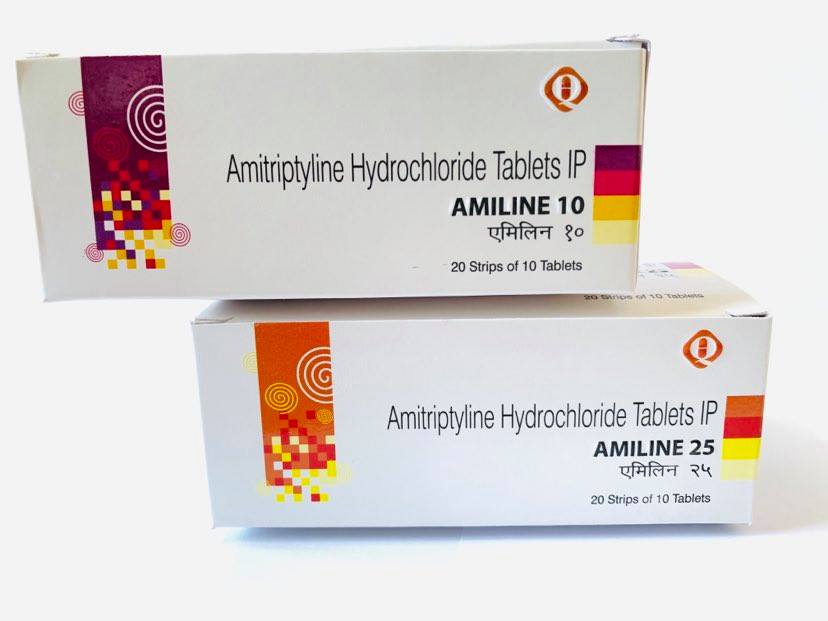


Each Tablet Contains Amitriptyline hydrochloride 10/25/75 mg.
Pack size: 20*10 Blisters
AMILINE may induce side effects similar to other tricyclic antidepressants. Some of the below mentioned side effects e.g. headache, tremor, disturbance in attention, constipation and decreased libido may also be symptoms of depression and usually attenuate when the depressive state improves. In the listing below the following convention is used: MedDRA system organ class / preferred term;
Very common (> 1/10);
Common (> 1/100, < 1/10);
Uncommon (> 1/1,000, < 1/100);
Rare (> 1/10,000, < 1/1,000);
Very rare (<1/10,000);
Frequency not known (cannot be estimated from the available data).
| MedDRA SOC | Frequency | Preferred Term |
|---|---|---|
| Blood and lymphatic system disorders | Rare | Bone marrow depression, agranulocytosis, leucopenia, eosinophilia, thrombocytopenia and purpur |
| Metabolism and nutrition disorders | Rare | Decreased appetite. |
| Frequency not known | Elevation or lowering of blood sugar levels. Increased appetite. Anorexia | |
| Psychiatric disorders | Very common | Aggression. |
| Common | Confusional state, libido decreased, agitation. | |
| Uncommon | Hypomania, mania, anxiety, insomnia, nightmares. | |
| Rare | Delirium (in elderly patients), hallucination (in schizophrenic patients), suicidal thoughts or behavior*. | |
| Frequency not known | Paranoia. | |
| Nervous system disorders | Very common | Somnolence, tremor, dizziness, headache, drowsiness, speech disorder (dysarthria). |
| Common | Disturbance in attention, dysgeusia. Paresthesia, ataxia. | |
| Uncommon | Convulsion | |
| Very Rare | Akathisia, polyneuropathy. | |
| Frequency not known | Weakness, disturbed concentration, disorientation, delusions, restlessness, peripheral neuropathy, inco-ordination, extrapyramidal disorder. | |
| Eye disorders | Very common | Accommodation disorder. |
| Common | Mydriasis | |
| Very rare | Acute glaucoma. | |
| Frequency not known | Blurred vision, dry eye | |
| Ear and labyrinth disorders | Uncommon | Tinnitus. |
| Cardiac disorders | Very common | Palpitations, tachycardia. |
| Common | Atrioventricular block, bundle branch block | |
| Uncommon | Collapse conditions, worsening of cardiac failure. | |
| Rare | Arrhythmia. | |
| Very rare | Cardiomyopathies, torsades de pointes. | |
| Frequency not known | Hypersensitivity myocarditis, myocardial infarction | |
| Vascular disorders | Very common | Orthostatic hypotension. |
| Uncommon | Hypertension. | |
| Frequency not known | Hyperthermia, stroke. | |
| Respiratory, thoracic, and mediastinal disorders | Very common | Congested nose. |
| Very rare | Allergic inflammation of the pulmonary alveoli and of the lung tissue, respectively (alveolitis, Loffler’s syndrome). | |
| Gastrointestinal disorders | Very common | Dry mouth, constipation, nausea. |
| Uncommon | Diarrhoea, vomiting, tongue edema. | |
| Rare | Salivary gland enlargement, ileus paralytic. | |
| Frequency not known | Epigastric distress, stomatitis, black tongue. | |
| Hepatobiliary disorders | Rare | Jaundice |
| Uncommon | Hepatic impairment (e.g. cholestasis liver disease). | |
| Not known | Hepatitis | |
| Skin and subcutaneous tissue disorders | Very common | Hyperhidrosis. |
| Uncommon | Rash, urticaria, face edema. | |
| Rare | Alopecia, photosensitivity reaction. | |
| Renal and urinary disorders | Common | Micturition disorders. |
| Uncommon | Urinary retention. | |
| Reproductive system and breast disorders | Common | Erectile dysfunction. |
| Uncommon | Galactorrhoea. | |
| Rare | Gynaecomastia. | |
| Frequency not known | Breast enlargement, testicular swelling, libido fluctuations, interference with sexual function, and syndrome of inappropriate ADH secretion. | |
| General disorders and administration site conditions | Common | Fatigue, feeling thirst. |
| Rare | Pyrexia | |
| Investigations | Very common | Weight increased. |
| Common | Electrocardiogram abnormal, electrocardiogram QT prolonged, electrocardiogram QRS complex prolonged, hyponatremia. | |
| Uncommon | Intraocular pressure increased. | |
| Rare | Weight decreased. Liver function test abnormal, blood alkaline phosphatase increased, transaminases increased. |